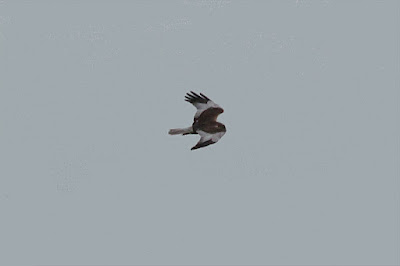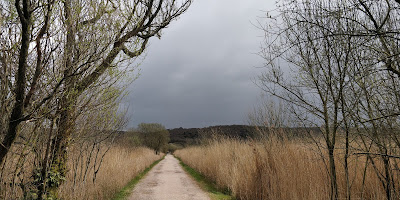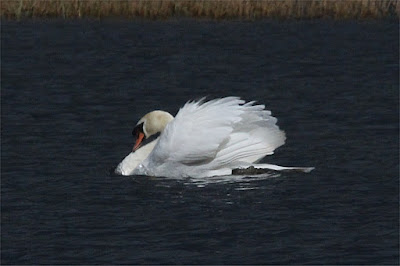 |
| Mute swan battle |
After rain stopped play yesterday I was keen to go out for a day's birdwatching. The wind was still a bit brisk so I decided to get an old man's explorer ticket and head off for Leighton Moss, which has the merits of being close to the station and having plenty of hides to shelter in if necessary.
The woodpigeons have been out in force on the school playing field across the road. There were fifty-nine of them this morning, together with a couple of dozen each of magpies and starlings.
On the way into Manchester I noticed that the pair of Canada geese on the canal under Pomona Station seem to have abandoned their nest. I don't think they'd been on there long enough to have successfully hatched any eggs. I've yet to see any goslings in town.
I got myself an old man's explorer ticket and caught the Barrow train. Despite the price hike it's still cheaper than the return to Silverdale and it gives me the option to roam about a bit if I want.
It was cloudy but not unpleasant when I got off the train at Silverdale. As we slowed down before the station we passed the coastal pools which were littered with black-headed gulls. A great white egret stalked the poolside while a few avocets and a few dozen black-tailed godwits fed in the pool by the Eric Morecambe Hide.
Spring was in the air, filled with the songs of coal tits, great tits, chaffinches and chiffchaffs. Pairs of mallards and pheasant's wandered around the paths by the visitor centre and a pair of bullfinches called from one of the trees. Every bush by the visitor centre seemed to have a blue tit and some goldfinches.
 |
| House martin and sand martin |
 |
| House martin |
I walked down to Lilian's Hide, passing a couple of singing wrens, a pair of goldcrests and a singing Cetti's warbler along the way. There were fewer ducks on the pool than last time, Winter visitors having mostly drifted off and a lot of the residents being busy in the reedbeds. The usual small raft of tufted ducks was there with a couple of goldeneyes in tow. A handful of female pochards dozed with the shovelers and a few mallards on the banks. Teal were noticeable by their absence. The black-headed gulls seemed to be still sorting out nesting territories and were making a noise about it. Out over midwater a small mixed flock of hirundines — sand martins, house martins and a few swallows — hawked low over the pool.
 |
| Male marsh harrier |
Walking down to the reedbed pool I noticed there'd been a bit more clearing and pruning of the willow trees down the path, opening up a few more unexpected views. A male marsh harrier flew low over the reedbeds accompanied by calls of protest by the black-headed gulls on the pools as he passed them by.
 |
| Willows |
There were a couple more Cetti's warblers singing by the path — by the end of the visit I wasn't sure if I'd heard seven or eight singing Cetti's — and my first reed warbler of the year was reeling off its song by the bridge over the main drain.
It was a lazy time at the Tim Jackson Hide, all the teals and shovelers were asleep while the gadwall, mallards and greylags quietly loaded on the little islands. A garganey had been reported here earlier in the day but I had no luck in finding one.
A flock of curlews flew over from the salt marsh, the brisk wind bringing their calls a couple of minutes before it brought them. A bittern boomed from the reedbeds from somewhere near the causeway.
 |
| Great black-backs |
 |
| Gadwalls |
At the Griesdale Hide the pair of great black-backs have claimed the osprey nesting platform as their own again this year. The gadwall, teal and mallards were a bit more active on this pool while sand martins and house martins hawked over it.
As I walked back I bumped into a pair of marsh tits. Their agitated behaviour and the male's unusual display of aggression in the bushes as I passed by suggested they had an active nest nearby so I didn't linger. At one point the male flew up into a bush a few inches away from my shoulder sneezing crossly as he raised the black crest on top of his head, something I've rarely seen done before.
 |
| The causeway |
Aside from the occasional half-hearted attempts at drizzle the weather was behaving itself and was even becoming pleasantly sunny so I wandered over to the Causeway hide passing a couple of Cetti's singing by the boardwalk. I kept an eye on the sky in the hopes of a passing osprey, there were lots of black-headed gulls and assorted hirundines and a couple of marsh harriers. The bittern carried on booming from somewhere in the reeds between the causeway and Lilian's pool.
 |
| Mute swans and cormorants |
 |
| Great crested grebe |
 |
| Mute swan and cormorants The acute angle of the yellow gular patch on the bird on the right shows it to be of the carbo subspecies typical of British coastal waters. |
The Causeway Pool was quietly busy with tufties, pochards and coots. A herd of last year's mute swan cygnets cautiously cruised the pool away from the pairs of adults. A pair of great crested grebes swam close to the hide.
 |
| The Causeway Pool |
The cob mute swans were in attack mode and a couple of them charged from opposite sides of the pool for a punch-up.
 |
 |
 |
 |
| Mute swans having a fight No men's arms were broken in the course of this action. |
The rain that had threatened arrived with a vengeance. I took the hint, got myself a pot of tea in the café and got the train home. I debated a few detours along the way but was tired after having had little sleep last night and decided I just wanted to go home. So the train home from Manchester was cancelled and I had to get the bus through the football traffic. I was too tired to let that take the gloss off an excellent day's birdwatching.

No comments:
Post a Comment